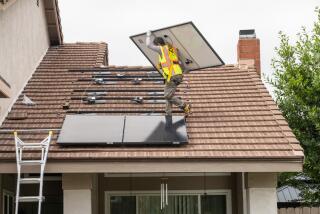Latest Capital-Infusion Deal for Sun Collapses
- Share via
SAN DIEGO — Sun Savings & Loan Assn., hammered by ever-mounting loan losses, on Wednesday night said that its capital base had virtually run out and that a much-needed equity-infusion proposal had been called off.
Sun reported a fourth-quarter loss of $4.6 million, which pushed losses for all of 1985 to $5.1 million and brought red ink in the past two years to $10.8 million.
The fourth-quarter loss depleted Sun’s net worth to $1.27 million, or only 0.003% of its $403 million in assets as of Dec. 31, far below the 3% net worth ratio required by regulators.
Sun officials said they will ask that trading in its stock on the American Stock Exchange be delayed this morning until news of its losses is fully disseminated. The stock closed Wednesday at $4.375, down one-eighth.
Sun’s much-delayed, much-altered capital-infusion offer from New York financier Van D. Greenfield was called off because the amount of money needed to boost Sun’s net worth to the regulatory minimum exceeded the amount Greenfield was willing to invest, according to Sun President and Chief Executive John McEwan. To meet regulatory standards, Sun would need a net worth, or an excess of assets over liabilities, of $12 million.
Greenfield’s proposal called for a cash infusion of $7 million, although sources close to Sun maintain that Greenfield was prepared to invest as much as $10 million.
Concurrently, a $2.47-million capital-infusion deal from local developer Victor Fargo has collapsed. That deal, which would have required Sun to move its headquarters to Fargo’s new La Jolla office building, was dependent on consummation of the Greenfield deal.
Sun’s latest losses stem primarily from $4.4 million in fourth-quarter loan write-offs and additions to loan-loss reserves. For the year, the reserves and write-offs totaled nearly $6.6 million.
Sun has written off $9.3 million in bad loans in the past two years, or 4.6% of its total loans.
The losses may continue to mount because Sun’s scheduled items, consisting mostly of loans delinquent more than 90 days, totaled $48.9 million at year’s end.
Most of the write-offs involve participation loans, with Sun’s involvement representing less than 6% of the total amounts.
The lead lenders of the majority of those loans are financial institutions that are now under regulatory supervision, McEwan said Wednesday.
As a result, regulators have reappraised those loans, and “we’re sitting here with 5% or 6% of a big project loan now under someone else’s control,” McEwan said. “It’s totally out of our control.”
Speculation about some type of federal action against Sun--either a cease-and-desist order or an outright takeover--has surfaced in recent weeks. In January, regulators entered into an agreement with Sun that limits asset and liability growth, but that agreement stopped short of takeover of management or the board.
McEwan said that regulators have reviewed Sun’s year-end audit but that he has had no discussions with them about any type of action against the company.
The collapse of the capital-infusion deal is the latest in a series of defeats that McEwan has weathered since being named Sun president and chief executive a year ago.
“This is difficult news to put out,” McEwan said. “But, nonetheless, we have some opportunities we’re going to pursue. And I don’t give up.”
McEwan said he will approach several interested investors and companies whose potential offers have been on the “back burner” because of the Greenfield proposal.
One offer involves another financial institution in California that McEwan declined to identify.
In a prepared statement, Sun cautioned that “there can be no assurance at this time” that any potential capital-infusion plan will be “successfully consummated.”
The collapse of the latest Greenfield offer is the third time that the New York financier has called off plans to invest in the ailing S&L.;
He withdrew a $10-million offer for Sun in November, 1984, after his financial analysis showed that Sun’s stock wasn’t worth the $11 per share he had originally agreed to pay.
Another Greenfield offer, combined with a capital infusion from developer Fargo, failed in October, after Sun’s stock price plunged to an all-time low of 3 1/8 per share.
The deal with Fargo was complicated, and Sun’s critics maintained that the proposal was merely a way for Fargo to secure permanent financing on a new La Jolla office building he developed.
Terms of the deal called for Fargo to invest $2.47 million into Sun. In exchange, Sun would lease 30,000 square feet of Fargo’s building for $13 million over the next 10 years. The company would also draw a 25% share of the lease profits and any proceeds from Fargo’s attempt to refinance a $17-million construction loan with $25 million in permanent loans.
Sun’s rent would have been about double and it would have had to sublet 25,000 square feet of corporate office space it had leased in University City in May.
Fargo would have used the money from the permanent financing to invest in Sun, sources said.
Fargo’s brother-in-law, Ted P. Van Leeuwen, is a Sun director and is also a tenant in Fargo’s La Jolla building. He abstained from voting on Fargo’s capital infusion proposal.
News of Sun’s losses and its eroding net worth comes on the heels of a major stock buy by New Jersey developer John J. Brunetti, who also owns the Hialeah race track in Florida. Since Jan. 10, Brunetti has purchased 9.95% of Sun’s stock, at about $4 per share, and this week said he plans to file for regulatory permission to increase his holdings to more than 10%.
More to Read
Inside the business of entertainment
The Wide Shot brings you news, analysis and insights on everything from streaming wars to production — and what it all means for the future.
You may occasionally receive promotional content from the Los Angeles Times.










